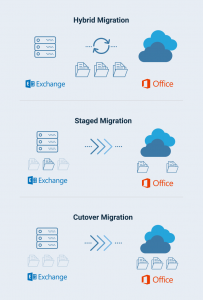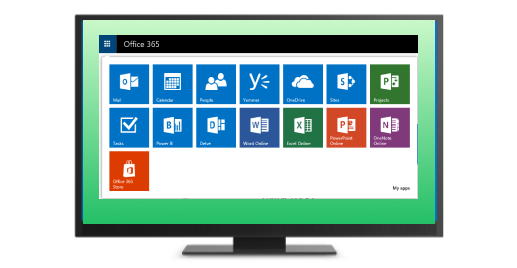Many organizations decide to skip the expense of maintaining an on-premises Exchange server and migrate to Office 365, which offloads the server to the Microsoft cloud (see all the reasons why it's time to perform Exchange to Office 365 migration). Once that decision has been made, the next step is to decide on the type of migration. In this article, we will overview the main types of Exchange cloud migration.
Table of Contents

Office 365 Hybrid migration is more complex than Cutover or Staged, with both the old internal server and the new Office 365 server handling email at the same time. However, it also offers a better chance for the admins to work the bugs out, to find and fix problems before the organization is moved exclusively to the new system. Since the old system remains in place, additional features such as eDiscovery, archiving, and security systems can remain in place while new configurations are tested on the Office 365 platform.
There are a number of requirements to use office 365 hybrid migration, one being that the version of on-premise Exchange must be 2010, 2013 or 2016, fully updated and patched, and preferably running at least one of each type of server role (mailbox, hub transport and client access for 2010, mailbox and client access for 2013, and mailbox for 2016) on the same system. Older versions of Exchange will require a third-party tool to migrate direction to Office 365. Third-party extensions to Exchange including archiving tools, e-discovery, mobile device management tools, older mobile devices themselves, voice, and video conferencing, and other multimedia tools may require separate migration paths as well.
Minimal Hybrid
Minimal office 365 hybrid migration, also known as Express Migration, is one of the options for hybrid migration, the other being the full hybrid migration. Full Migration is a longer-term migration that can include support for extra features, such as free/busy scheduling, e-discovery, archiving, multi-media, or integration with SharePoint.
Minimal Hybrid Configuration Use-Cases
If an organization is running a relatively simple Exchange configuration, not using the advanced features such as e-discovery, free/busy sharing, or workflows, has a relatively small number (a maximum of 2,000 mailboxes) of users, groups, and departments, and is looking for a quick, simple migration, a minimal hybrid Configuration is a good option.
- Small or medium-sized customers that need a seamless migration experience for their users.
Small or mid-sized companies, particularly ones that aren’t using the advanced scheduling or multimedia features of Exchange, but that want a little insurance against problems can use the minimal hybrid migration to produce an effect similar to the cutover migration but with the ability to do some troubleshooting and additional configuration before moving over to the new configuration permanently.
There are many features of Exchange beyond email, including scheduling of personnel and resources such as conference rooms, archiving of information for legal discovery purposes, interfacing with third-party video conferencing systems or VoIP phone systems, and more. Companies that use these types of systems will want to go with the Full Hybrid configuration.
- Customers that plan on moving to the service quickly
Customers that plan to have an extended period between starting the migration and moving to the new Office 365 system permanently (more than two weeks or so), should consider the Full Hybrid approach. If the two-week period is enough, then the Minimal Hybrid approach should be simpler and easier to implement.
- Merger or acquisition scenarios
Companies that have acquired or merged with other organizations that had been running Exchange on-premise may benefit from the Minimal Hybrid configuration since you can move the mailboxes to a tenant without having to configure all of the Hybrid features. Learn more about how to protect Office 365 tenants in these articles:
Further reading Securing Your Office 365 Tenants. Part 1
Further reading Securing Your Office 365 Tenants. Part 2
- Other cases
Many other products add functionality to Exchange, providing backups, archiving, e-Discovery, and other features. Migrating those services from the versions supporting the on-premises Exchange Server to a cloud-based service that works with Office 365 can introduce additional complexity. It’s worthwhile to investigate this separate migration well in advance of the migration of Exchange. If an organization doesn’t have a backup strategy separate from the tools available in Exchange, solutions for Office 365 backup can create a full backup of the Exchange server, domain information, and other configuration information, and restore that to an Office 365 instance if something goes wrong during a Hybrid Migration.
When you need Full Hybrid Migration?
When the Hybrid operation will be maintained for more than a couple of weeks, the Full Hybrid migration should be considered. Likewise, customers that are using advanced features, from free/busy scheduling, e-discovery, archiving, multi-media, or that have integration with SharePoint or other systems, should consider Full Hybrid migration.
When You Need to Maintain Exchange On-Premises for Recipient Administration Purposes
Where groups of recipients have special functions or extra requirements, it may be useful to maintain an Exchange server on-premises to handle their needs. If this will be a long-term solution, then the Full Hybrid migration may offer benefits to the administrator in terms of being able to maintain the on-premises server after the rest of the organization functions have moved to Office 365.
Conclusion
Microsoft’s online docs include hundreds of pages on migration from Exchange to Office 365, which can help you determine which migration process is the best for your organization. Any additional add-ons to Exchange or Outlook may introduce additional factors to the migration process. Many steps must be completed before any migration, from verifying the ownership of your DNS domain to applying any recent patches to the Exchange Server and Outlook clients. Planning out the migration is a must, even for small 20-person email systems, and the more complex your environment, the more planning, backups, and precautions you should have.




